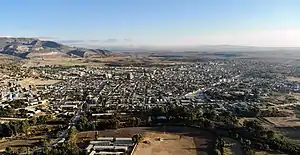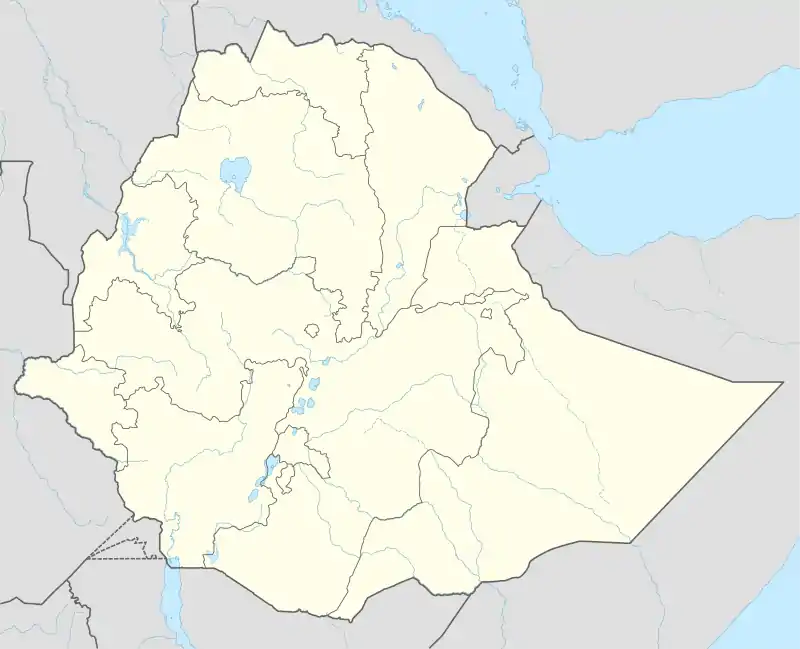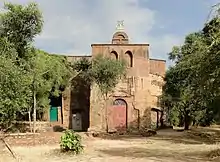Wukro
Wukro (Ge'ez: ውቕሮ) (also known as Wukro Kilte Awulaelo; Ge'ez: ውቕሮ ክልተ ኣውላዕሎ) (also transliterated Wuqro;[1] formerly known as Dongolo (Ge'ez: ዶንጎሎ) is a town and separate woreda in Tigray, Ethiopia. It's located along Genfel River, in the Misraqawi (Eastern) zone of the Tigray region on the Asmara-Addis Ababa highway (Ethiopian Highway 2). Wukro is surrounded by Kilte Awulaelo woreda. The rock-hewn churches around Wukro are the town's most distinctive landmarks; in the early 20th century the town's name was changed from "Dongolo" (Ge'ez: ዶንጎሎ) to the Tigrigna word for a structure carved from the living rock, Wukro.[2]
Wukro
ውቕሮ | |
|---|---|
City | |
 | |
 Flag | |
 Wukro Location within Ethiopia | |
| Coordinates: 13°47′N 39°36′E | |
| Country | Ethiopia |
| Region | Tigray |
| Zone | Misraqawi (Eastern) |
| District | Wukro |
| Elevation | 1,972 m (6,470 ft) |
| Population (2007) | |
| • Total | 30,210 |
| Time zone | UTC+3 (EAT) |
| Climate | BSh |
History

Origins
Francisco Álvares was the first European recorded to have visited Wukro, when in 1521 he stayed at the royal inn or Betenegush. His account also includes a description of Maryam Wukro church "made in a rock, hewn and wrought with the pickaxe, with three aisles and their supports made of the rock itself."[3]
19th Century
The next important European visit was in 1868 when Lieutenant-General Sir Robert Napier passed through the village on his way to Magdela where he defeated the Ethiopian Emperor Tewodros II.[4] During their march through Wukro, members of the British army saw one of the Tigrayan rock-hewn churches, most likely Wukro Chirkos, and were afterwards thought to be the first Europeans to see these unusual structures;[5] another notable landmark is the more recent church Wukro Giyorgis Bete.
20th Century
During the Italian occupation, in 1938, there were shops and a hotel-restaurant, a car service station, a telephone and telegraph office and a health post. It was qualified as an “Italian town under development”.[6] Many of these buildings are still present, just south of the bridge. Francesco Baldassare started a mill in Wukro, but abandoned it when the Italians were defeated in 1941.[7] Wukro was used as his headquarters by Blatta Haile Mariam Redda during the Woyane rebellion, until Ras Abebe Aregai captured the town 17 October 1943.[8] Dawit W. Girgis reports in his memoirs that in 1964, with the permission of Emperor Haile Selassie, the Israelis operated a secret base outside Wukro where members of the Anyanya (a Sudanese rebel group) were trained in guerrilla warfare.[7]
During the Ethiopian Civil War, Wukro was repeatedly attacked by Derg aircraft in 1988, resulting in the deaths of a total of 175 residents.[9]
Economy
Local industry includes Sheba Tannery, which is capable of processing 6,000 hides a day. Opened in 2004, the tannery is one of the 13 companies owned and managed by the Endowment Fund for the Rehabilitation of Tigray (EFFORT).[10]
Kuwaiti Prime Minister Sheikh Nasser Mohammed Al-Ahmed Al-Sabah announced in July 2009, during a 3-day visit to Ethiopia, that his country would provide a $63 million loan to Ethiopia, part of which would be used to build a road between Wukro and Zalambessa near the Eritrean-Ethiopian border.[11]
Demographics
In 1938, the town counted 368 inhabitants (including 78 Italians).[6]
Based on the 2007 national census conducted by the Central Statistical Agency, this town has a total population of 30,210, of whom 14,056 are men and 15,154 are women. A total of 9,383 households were counted in this town, resulting in an average of 3.22 persons to a household, and 8,993 housing units. The majority of the inhabitants said they practiced Ethiopian Orthodox Christianity, with 92.94% reporting that as their religion, while 6.03% of the population were Muslim.[12]
The 1994 census reported the town had a total population of 16,421 of whom 7,427 were men and 8,994 were women. It is the largest settlement in Wukro woreda.
See also
Notes
- Like many proper names in Ethiopia, there are a number of transliterations of this name into English. David Buxton lists the many ways Wukro "has been variously spelt: Agroo, Corou, Oucro, Ouquo, Ucro, Ouaqero, Oukero, Ouogro, Uogro, Woghuro, Wogro, Waqro, and Weqro. Some of these forms...are influenced by French or Italian spelling conventions" The Abyssinians (New York: Praeger, 1970), p. 16
- David W. Phillipson, Ancient Churches of Ethiopia (New Haven: Yale University Press, 2009), p. 94
- Francisco Alvarez, The Prester John of the Indies, translated by C.F. Beckingham and G.W.B. Huntingford (Cambridge: Hakluyt Society, 1961), pp. 176ff
- Philip Briggs, Ethiopia: The Bradt Travel Guide, 3rd edition (Chalfont St Peters: Bradt, 2002), p. 239
- David Buxton, Travels in Ethiopia, second edition (London: Benn, 1957), p. 126; David Phillipson, Ancient Churches, p. 94
- Consociazione turistica Italiana. Guida dell'Africa orientale Italiana. Milano. p. 300.
- "Local History in Ethiopia" The Nordic Africa Institute website (accessed 6 December 2007)
- Paul B. Henze, Layers of Time: A History of Ethiopia (New York: Palgrave, 2000), pp. 250f
- Africa Watch, Ethiopia: "Mengistu has Decided to Burn Us like Wood": Bombing of Civilians and Civilian Targets by the Air Force, 24 July 1990, p. 10
- "Sheba Tannery Plc", EFFORT website
- "Kuwait Loans Ethiopia EUR45 Million For Electricity, Roads - Report", Addis Live website, 21 July 2009 (accessed 19 August 2009)
- Census 2007 Tables: Tigray Region, Tables 2.1, 2.4, 2.5 and 3.4.